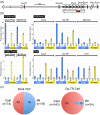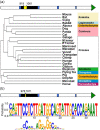The mouse DXZ4 homolog retains Ctcf binding and proximity to Pls3 despite substantial organizational differences compared to the primate macrosatellite
- PMID: 22906166
- PMCID: PMC3491370
- DOI: 10.1186/gb-2012-13-8-r70
The mouse DXZ4 homolog retains Ctcf binding and proximity to Pls3 despite substantial organizational differences compared to the primate macrosatellite
Abstract
Background: The X-linked macrosatellite DXZ4 is a large homogenous tandem repeat that in females adopts an alternative chromatin organization on the primate X chromosome in response to X-chromosome inactivation. It is packaged into heterochromatin on the active X chromosome but into euchromatin and bound by the epigenetic organizer protein CTCF on the inactive X chromosome. Because its DNA sequence diverges rapidly beyond the New World monkeys, the existence of DXZ4 outside the primate lineage is unknown.
Results: Here we extend our comparative genome analysis and report the identification and characterization of the mouse homolog of the macrosatellite. Furthermore, we provide evidence of DXZ4 in a conserved location downstream of the PLS3 gene in a diverse group of mammals, and reveal that DNA sequence conservation is restricted to the CTCF binding motif, supporting a central role for this protein at this locus. However, many features that characterize primate DXZ4 differ in mouse, including the overall size of the array, the mode of transcription, the chromatin organization and conservation between adjacent repeat units of DNA sequence and length. Ctcf binds Dxz4 but is not exclusive to the inactive X chromosome, as evidenced by association in some males and equal binding to both X chromosomes in trophoblast stem cells.
Conclusions: Characterization of Dxz4 reveals substantial differences in the organization of DNA sequence, chromatin packaging, and the mode of transcription, so the potential roles performed by this sequence in mouse have probably diverged from those on the primate X chromosome.
Figures







Similar articles
-
Characterization of the ICCE Repeat in Mammals Reveals an Evolutionary Relationship with the DXZ4 Macrosatellite through Conserved CTCF Binding Motifs.Genome Biol Evol. 2018 Sep 1;10(9):2190-2204. doi: 10.1093/gbe/evy176. Genome Biol Evol. 2018. PMID: 30102341 Free PMC article.
-
Characterization of DXZ4 conservation in primates implies important functional roles for CTCF binding, array expression and tandem repeat organization on the X chromosome.Genome Biol. 2011;12(4):R37. doi: 10.1186/gb-2011-12-4-r37. Epub 2011 Apr 13. Genome Biol. 2011. PMID: 21489251 Free PMC article.
-
DXZ4 chromatin adopts an opposing conformation to that of the surrounding chromosome and acquires a novel inactive X-specific role involving CTCF and antisense transcripts.Genome Res. 2008 Aug;18(8):1259-69. doi: 10.1101/gr.075713.107. Epub 2008 May 2. Genome Res. 2008. PMID: 18456864 Free PMC article.
-
CTCF: master weaver of the genome.Cell. 2009 Jun 26;137(7):1194-211. doi: 10.1016/j.cell.2009.06.001. Cell. 2009. PMID: 19563753 Free PMC article. Review.
-
Macrosatellite epigenetics: the two faces of DXZ4 and D4Z4.Chromosoma. 2009 Dec;118(6):675-81. doi: 10.1007/s00412-009-0233-5. Epub 2009 Aug 19. Chromosoma. 2009. PMID: 19690880 Review.
Cited by
-
Trio-binning of a hinny refines the comparative organization of the horse and donkey X chromosomes and reveals novel species-specific features.Sci Rep. 2023 Nov 17;13(1):20180. doi: 10.1038/s41598-023-47583-x. Sci Rep. 2023. PMID: 37978222 Free PMC article.
-
Loss of SETDB1 decompacts the inactive X chromosome in part through reactivation of an enhancer in the IL1RAPL1 gene.Epigenetics Chromatin. 2018 Aug 13;11(1):45. doi: 10.1186/s13072-018-0218-9. Epigenetics Chromatin. 2018. PMID: 30103804 Free PMC article.
-
Rapid Macrosatellite Evolution Promotes X-Linked Hybrid Male Sterility in a Feline Interspecies Cross.Mol Biol Evol. 2021 Dec 9;38(12):5588-5609. doi: 10.1093/molbev/msab274. Mol Biol Evol. 2021. PMID: 34519828 Free PMC article.
-
Plastin 3 in health and disease: a matter of balance.Cell Mol Life Sci. 2021 Jul;78(13):5275-5301. doi: 10.1007/s00018-021-03843-5. Epub 2021 May 23. Cell Mol Life Sci. 2021. PMID: 34023917 Free PMC article. Review.
-
Characterization of the ICCE Repeat in Mammals Reveals an Evolutionary Relationship with the DXZ4 Macrosatellite through Conserved CTCF Binding Motifs.Genome Biol Evol. 2018 Sep 1;10(9):2190-2204. doi: 10.1093/gbe/evy176. Genome Biol Evol. 2018. PMID: 30102341 Free PMC article.
References
-
- Lander ES, Linton LM, Birren B, Nusbaum C, Zody MC, Baldwin J, Devon K, Dewar K, Doyle M, FitzHugh W, Funke R, Gage D, Harris K, Heaford A, Howland J, Kann L, Lehoczky J, LeVine R, McEwan P, McKernan K, Meldrim J, Mesirov JP, Miranda C, Morris W, Naylor J, Raymond C, Rosetti M, Santos R, Sheridan A, Sougnez C. et al.Initial sequencing and analysis of the human genome. Nature. 2001;409:860–921. doi: 10.1038/35057062. - DOI - PubMed
-
- Ellegren H. Microsatellites: simple sequences with complex evolution. Nat Rev Genet. 2004;5:435–445. - PubMed
Publication types
MeSH terms
Substances
Grants and funding
LinkOut - more resources
Full Text Sources
Other Literature Sources
Molecular Biology Databases

